Lamp holder: device principle, types and connection rules
You have to replace the bulb holder with a new one, but you don’t know how to do it correctly so as not to damage important wires and components? For such a simple job, I do not want to call an electrician, whose services will cost quite expensive, right? Or do you need to upgrade your home electrical system with the replacement of individual elements?
We will help to deal with the features of connecting various cartridges - the article discusses the main varieties and marking of factory electrons.
Also given are instructions for connecting a cartridge with threaded terminals and reviewed existing options for mounting it in lighting installations. Visual photos with a step-by-step process of connecting and installing, and videos showing the replacement of the cartridge, the correct connection of wires to it were selected.
The content of the article:
Purpose and features of the cartridge
A production or home electrical network consists not only of wires and fixtures, but also of many electrical installations that serve to control or connect individual parts of the circuit.
The lampholder connects the lamp base to the electric cable and at the same time fixes it in the lamp, chandelier or simply holds it in suspension.
The problem of quick replacement of lamps arose immediately, as electric lighting was invented, that is, at the end of the 19th century. The first lamps had socles, but the methods for connecting them to the wires were different and did not have a classification.
In 1881, Edison patented the first threaded-type cap and cartridge for it. Thus, the most popular types of socles and cartridges remain relevant for more than 130 years.
Of course were originally invented incandescent lamps. Then gas-discharge and LED appeared; for their installation, both familiar and structurally different varieties of cartridges were required.
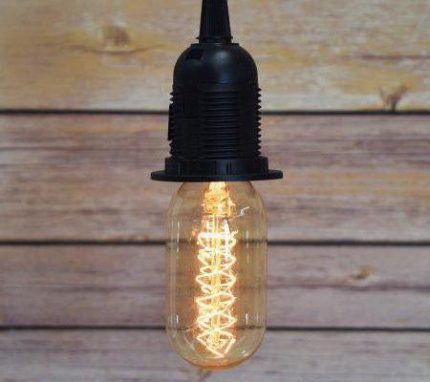
For the manufacture of modern cartridges, various materials are used, among which you can find traditional metal and ceramics, as well as heat-resistant polymers and even silicone.
The latter option is most often used to create designer compositions. Silicone products are equipped with a 1 m power cord and are painted in all colors of the rainbow.
When buying a sconce, chandelier or other lamp, you need to carefully pay attention to the manufacturer's recommendations: if you install too powerful lamps, lampholders can fail, and the ceiling can be deformed.
Types of electric cartridges by type of cap
As already mentioned above, two large categories of cartridges remain in demand - under the threaded base and under the pins. They are often universal, i.e. suitable for different types of lamps.
For example, incandescent lamps and stylized ones are equipped with threaded LED fixtures.
But some products can interact with only one option. Let us consider in more detail their design features and technical characteristics that you need to rely on when choosing.
No. 1 - popular threaded options
Cartridges with internal thread are designed for lamps with a threaded base. It is customary to designate the dimensions in the same way: for example, for a lamp with an E14 socket, an appropriate E14 socket is needed, although a variant with an adapter from E27 to E14 is possible.
The numbers 14 and 27 indicate the diameter, with 27 often considered as the classic size, and 14 are called the minion.
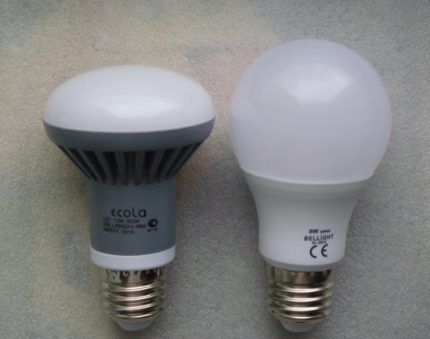
Only 8 sizes of socles, therefore, the same number of cartridges for them: E5, E10, E12, E14, E17, E26, E27, E40.
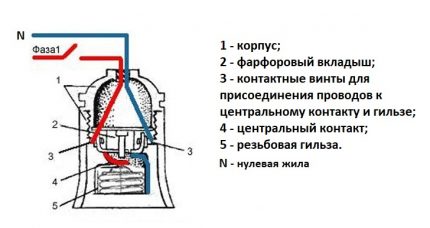
The most popular are plastic products. They have a limited service life and are subject to the requirements set forth in GOST 2746.1-88. The method of attachment of the cartridge may differ and be suspended, with a straight or inclined flange.
The first is used for mounting on the ceiling or mounting hardware, and flanged - for installation on the surface.
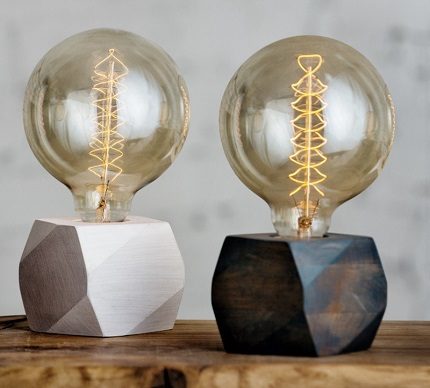
The table of characteristics of the most common threaded lampholders for connecting lamps to the electric network, which differ in size. The larger the diameter of the cartridge, the higher the power and load current.
| Cartridge size | Maximum power, W | Load current, A | Appointment |
| E14 | 440 | 2 | Cartridge with internal thread ∅14 mm, which is also called "minion". We use for incandescent lamps of household type with low power |
| E27 | 880 | 4 | Chuck with internal thread ∅27 mm, which is considered traditional, but is increasingly being replaced by ∅14 mm. It is applied to various types of lamps of average power |
| E40 | 3500 | 16 | Ceramic cartridge with резь40 mm internal thread. Serves for connecting high-power lamps needed for street or industrial lighting |
The case is made of various types of plastic, so before using the lamp, you must study the marking - find out the permissible power of the lighting device.
If you screw in a light bulb of increased power, then the plastic will melt or gradually break up due to regular heating.
No. 2 - variety of pin varieties
Requirements and standards for pin cartridges are available in GOST R 60400-99. They operate from a 220 V network. The letter G denotes the type of cartridge (pin), and the next digit is the distance between the two holes for the pins.
If the contacts are not 2, but 4, then the diagonal distance between the opposite holes (grooves) is indicated. Special types are marked with additional Latin letters or numbers.

Chucks for pins are used for domestic and industrial premises, as well as for fixtures that are installed on the street - along park paths, carriageways, to illuminate areas or adjoining areas.
| Cartridge size | Maximum power, W | Load current, A | Appointment |
| G4-g10 | 60 | 5 | Versions from G4 to G10 inclusive are suitable for the installation of low power halogen lamps. The number after the “G” is the distance in millimeters between the pins |
| G9 | 60 | 5 | Lamps for cartridges G9 have a loop-shaped flat base, which is inserted into special grooves |
| GU10 | 50 | 5 | Cartridge analog for G10 cap. The lamps at the ends of the pins have bulges that are inserted into the holes and then secured with a swivel movement |
| G13 | 80 | 4 | Cartridge for linear lamps for various purposes. Features - pair use and rotary connection mechanism |
| Gx53 | 50 | 5 | An analogue of G10, but with an increased distance between the pins - 53 mm. Designed for installation in suspended structures, therefore, has a minimum thickness. |
To install U-shaped and cylindrical lamps, lampholders GX23, G24, 2G7 are used. They differ in the number of contacts - 2 or 4, have a load current of 2 A. Recommended lamp power - up to 75 W (for 2G7 - 50 W).
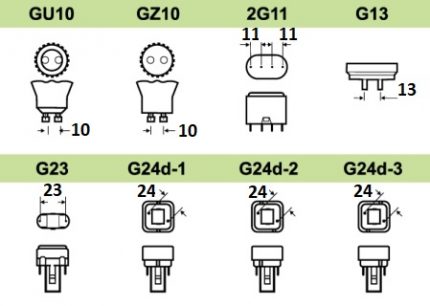
Thus, pin cartridges can differ in the following characteristics:
- case material;
- material of the inner liner;
- type of attachment of the cartridge to the base and wires;
- number of contacts;
- distance between contacts.
All of the above parameters can be indicated when marking the product.
Linear elongated gas discharge lamps have a slightly different type of mount. In addition to the fact that the cartridges are paired (the lamp is inserted from both sides), they are designed to operate on 220 V and 380 V networks, while the rated current is 1 A or 2 A.
By design, the cartridges are end, suspension and rack-mount - it also depends on the type of lamp used. The number of contacts can be different: for example, with a conductive strip, three instead of the usual two.
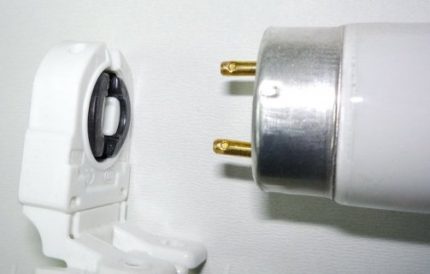
In order for the cartridge to work out the warranty period, it is necessary to follow the installation rules, select the product according to the technical characteristics of the lamp, choose the right one degree of protection (moisture- or dustproof).
In addition to cartridges for pin and threaded plinths, there are products for other types: focusing, pin, with recessed contact, spotlights.
They are used to install and connect LED and gas-discharge lighting devices.
Additional information on the types of cap is described in the articles:
- LED lamp bases: types, marking, technical parameters + how to choose the right one
- Types of lamp caps: standard marking and varieties of lamp caps
Factory marking
Professional electricians are not satisfied with one size and a quick visual inspection of the product, they carefully read the markings applied with indelible ink or embossed on the visible part of the cartridge.
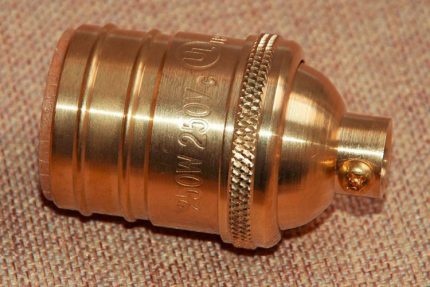
The most responsible manufacturers and markers affix and attach to the product brief manuals listing important characteristics.
The list of parameters that can be found on the cartridge is not always complete.
Usually any of the listed characteristics are reflected:
- type, for example, threaded, pin;
- the size;
- temperature;
- load current;
- power;
- voltage;
- manufacturer’s trademark;
- level of protection;
- the presence of a grounding contact.
Before purchasing cartridges, study the manufacturer’s website, where detailed technical information and a diagram with dimensions are usually posted.
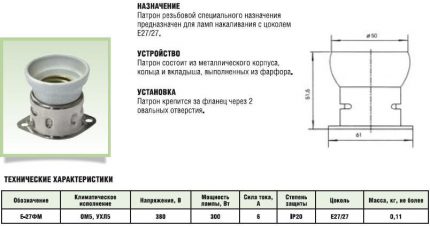
When choosing, it is also worth considering that ceramics are stronger than plastic and can withstand higher temperatures. If the cost of the product is doubtfully low, it is likely that it is a fake.
It is better to play it safe and buy a more expensive, but high-quality electro-cartridge of the well-known brand.
How to connect the cartridge?
Of household products, it is most difficult to connect the wires to the old type of cartridge - “Soviet”, since it must be disassembled beforehand.
These devices are easily recognizable by the black polymer case. To get to the terminals, the carbolite body must be unscrewed.
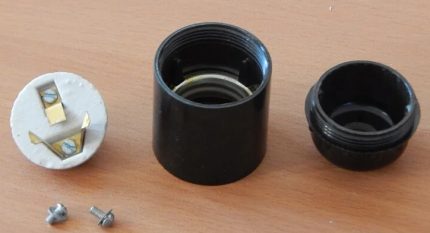
To fix the wires, they must be cleaned and decorated with “loops”, so that it is more convenient to fix on the contacts. The phase is fixed to the central screw-contact, zero to the second terminal.
When tightening a threaded connection, you must apply force and remember that it simultaneously transfers voltage to the contact. When the wires are connected, it remains to connect the two parts of the housing.
Mounting methods in lighting fixtures
The difficulty of installing a cartridge can be caused by the design of a chandelier or lamp. To quickly deal with the replacement of a broken product, we recommend that in advance, before the initial installation of the lighting device, get acquainted with its device and position.
Lamp manufacturers most often choose the following ways of attaching cartridges:
- for the electric wire;
- on a metal tube;
- using a sleeve;
- snaps.
Option number 1. When attaching to an electric drive, it is necessary to further strengthen the wire; for this, a sleeve with a fixing screw is used, which is screwed into the bottom of the cartridge.
Option number 2. A metal tube is used more often, since it allows you to install heavy chandeliers with a large number of decorative elements.
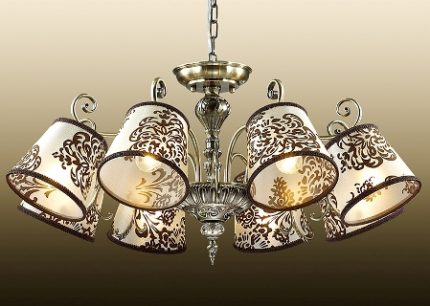
Option number 3. Cartridges with bushings are subjected to heating, as a result of which the elements are deformed. Therefore, it is recommended that plastic bushings be replaced with metal ones.
Option number 4. The last mounting method is suitable for devices with screwless terminals. The cartridge is installed in parts. First fix the bottom, then insert the wires, and only then mount the rest of the cartridge using latches.
Connection option with threaded terminals
Cartridges of a more modern type do not need to be disassembled - the terminals are on the outside. The wires are fixed with screw clamps, the connection process takes only a few minutes.
The only negative of such a cartridge is the impossibility of repair. If the terminals are burned or the product is deformed, you will have to completely change it.
The connection option with clamps is relevant for fixtures designed for E14 and E27 lamps. When installing a new cartridge and replacing it, be sure to check it for integrity and compliance.
Suppose the number of turns should be at least three, and the crack and chips should not be on the case.
Conclusions and useful video on the topic
The installation of various lighting fixtures may differ, therefore, we present several video instructions for connecting.
Connection of ceramic and carbolite cartridge:
Option for attaching wires to a plastic cartridge:
Cartridge replacement G4:
The cartridges are arranged quite simply, so you can do it yourself, disassemble, replace or repair home electrical installations.
The most important thing in this case is to turn off the mains voltage, if you are working with a lighting device, strictly follow the recommendations of experienced electricians. When installing a new model, you must adhere to the manufacturer's instructions.
Is there anything to supplement, or have questions about choosing and replacing a bulb holder? You can leave comments on the publication, participate in discussions and share your own experience. The contact form is located in the lower block.

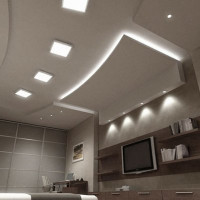 Bulbs for suspended ceilings: rules for the selection and connection + layout of lamps on the ceiling
Bulbs for suspended ceilings: rules for the selection and connection + layout of lamps on the ceiling 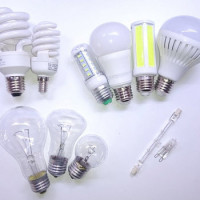 Which bulbs are best for the home: which are + rules for choosing the best bulb
Which bulbs are best for the home: which are + rules for choosing the best bulb 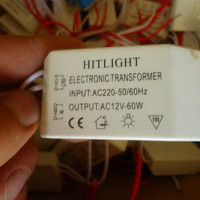 Transformer for halogen lamps: why is it needed, the principle of operation and connection rules
Transformer for halogen lamps: why is it needed, the principle of operation and connection rules  Bulbs for spotlights: types, characteristics, nuances of choice + best brands
Bulbs for spotlights: types, characteristics, nuances of choice + best brands 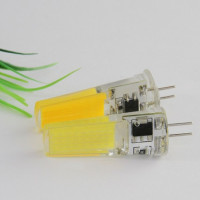 LED bulbs g4 to 12v: features, rules of choice + review of the best manufacturers
LED bulbs g4 to 12v: features, rules of choice + review of the best manufacturers 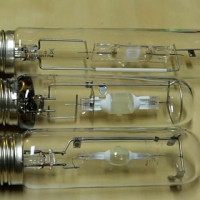 Metal halide lamps: types, device, pros and cons + selection rules
Metal halide lamps: types, device, pros and cons + selection rules  How much does it cost to connect gas to a private house: the price of organizing gas supply
How much does it cost to connect gas to a private house: the price of organizing gas supply  The best washing machines with dryer: model rating and customer tips
The best washing machines with dryer: model rating and customer tips  What is the color temperature of light and the nuances of choosing the temperature of the lamps to suit your needs
What is the color temperature of light and the nuances of choosing the temperature of the lamps to suit your needs  Replacement of a geyser in an apartment: replacement paperwork + basic norms and requirements
Replacement of a geyser in an apartment: replacement paperwork + basic norms and requirements
By the way, about cartridges with the marking "G". When they did the repair, stumbled upon it, it became interesting what kind of labeling it was. I read many articles. All these markings and features. It was useful to clarify this issue just before installing the spotlights. Still, you need to know what you are dealing with, and this information may come in handy later in life.Then he looked at the circuit.
I do a lot of things at home with my own hands, but knowledge is often not enough. Therefore, I am educating myself on the Internet. Now I wanted to make the lighting in the new house myself, the material and video recommendations for working with cartridges came in handy, it is clear that the markings on the lamp base and the cartridge must match. Correctly connecting the cartridge also proved to be easy.